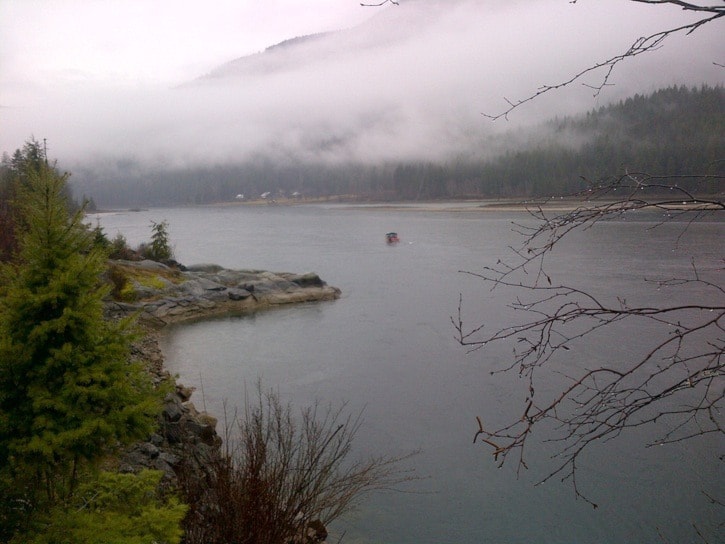BC Hydro says it doesn’t know yet whether it will proceed to the next phase of a project to deepen Grohman Narrows, but public feedback at a meeting last week could play a big part in that decision.
The company says its plan to deepen Grohman Narrows by one to four metres would provide flood control for property owners on the West Arm of Kootenay Lake and supply more power generating opportunities below the narrows.
Grohman Narrows is a constriction in the Kootenay River about three kilometers west of Nelson. The project would not involve widening the channel, just deepening it.
Hydro has been studying the proposed dredging of the narrows for several years at the request of local governments following the floods of 2012, according to Nelson mayor Deb Kozak. She told the Star that in addition to the desire to avoid another year like 2012, they saw climate change is expected to bring more rain than snow in the future as well as more extreme weather events.
“Local government got together at the time,” said Kozak, “and asked BC Hydro what we could do.”
Even though some of the hydro generation on the Kootenay River below Grohman is owned by FortisBC, Nelson Hydro, and the Columbia Power Corporation, BC Hydro is responsible for planning the overall operations of the Canadian dams in the Kootenay River system, but limited by each of those players’ water licence.
Hydro acknowledges the project would have the side benefit of increased power production on the Kootenay River dams downstream, but says this is not its primary motivation.
The dredging would cost between $21 million and $68 million, depending on the extent of the project, and it would take BC Hydro 40 years or more to recoup the costs through hydro generation.
Hydro has been studying the proposal for a few years and has had several public meetings including a well-attended open house in Nelson on Thursday evening.
“What came out of the previous public meeting here,” Hydro engineer Kelvin Ketchum told the Star, “were some real concerns around ‘Are you going to empty the lake?’ and also ‘What about downstream flows at Brilliant and down to Trail?’”
BC Hydro has since done studies to clarify some of those things and the results were shown in a series of graphics around the room at the open house, and also at a special meeting between Hydro and Regional District of Central Kootenay directors the day before.
Ketchum said the depth of the dredging would determine the new lake level, and that Hydro is considering dredging to the point where it could maintain the lake at a minimum of 1,738 feet (529 m). In 2012, the lake rose to 1,753.8 feet (534.5 m).
He says Hydro’s studies show that a level of 1,738 feet would have no effect downstream from Grohman, and would affect the West Arm only in certain months of the year.
“Excavating Grohman will only affect the lake level from March to possibly early July,” he said. “The rest of the year it will have no impact on the lake because in those months the Corra Linn dam controls the lake.
“So for years like 2012, if we excavate the narrows, we could keep the peak level of Kootenay Lake one to two feet (0.3 to 0.6 m) lower than we could have otherwise.”
BC Hydro still plans further engineering studies directly related to the dredging, as well as kokanee and white sturgeon spawning surveys.
Regional district Area E director Ramona Faust says she has residents who favour the proposal, and others who think lowering the lake might be risky. She represents much of the rural area around Nelson and up the lake.
“A lot of people who built in the ‘80s and early ‘90s are really hoping for flood control,” Faust told the Star. “But we don’t want another reason to have to move the ferry docks. My communities are finding that an upsetting prospect. And there are all the recreational features that rely on a fairly sensitive regime.”
Faust says Hydro’s proposed voluntary limit of 1,738 feet might satisfy those concerns. She said 1,738 feet is the threshold for water too shallow for the Kootenay Lake ferry.
“Mostly the RDCK directors are on wait and see,” she said. “There is no harsh opposition.”
Area F director Tom Newell, whose area runs from Bonnington up the North Shore to Crescent Beach, including Grohman, seemed quite satisfied with the information provided by Hydro.
“The various issues that may be raised, like fish and ferries, would be looked at in their second phase, so there is plenty of time to see what the full impacts would be.”
Ketchum told the Star written feedback from the open house might determine whether Hydro continues its studies.
“If there is a massive outcry against it,” he said, “I suspect we will say it is not worth it. We are looking for the general public’s support because this is not a project that Hydro would do on its own. The power benefits are just barely enough to cover the cost of the excavation.”
